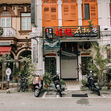Conversion of Old Shophouses in George Town, Penang
- Mohd Ismail Isa
- Feb 10, 2021
- 6 min read
Crowned with UNESCO World Heritage Site status in 2008, George Town has attracted tourists from all over the globe to enjoy charming colonial buildings with unique architectural styles. Most of these colonial buildings are the old shophouses that illustrate the living heritage of George Town. Despite its contribution to maintaining the Outstanding Universal Value (OUV), these old shophouses are challenged by tourism demands that turned them into luxury boutiques, hipster cafes, and other modern commercial properties; as observed in Armenian Street and Church Street. Further compounding this issue is the old shophouses structure has been modified without adhering to the heritage guidelines. Given the tremendous benefits of the tourism industry and the State Government prioritising investment (domestic and foreign) for economic growth (which indirectly triggered by the tourism industry), conservationists are voicing their concerns over protecting these heritage assets.
George Town, Penang's capital city, features a charming colonial charm that attracted tourists to visit the city of this gem located in the Straits of Malacca. However, local heritage preservationists are concerned with the attraction of old shophouses in the historic area of Georgetown, listed as a UNESCO World Heritage Site and where Malay, Chinese and Indian ethnic traders live and run businesses, fading out to give way to the emergence of luxury boutiques, hipster cafes and other modern commercial properties. Municipal officials and developers' efforts to earn more revenue from tourism by bringing in new projects and taking advantage of 'selling' a list of heritage sites, threatening to undermine the city's 'living heritage'. Local authorities seem to be more concerned with tourism and investment than maintaining George Town's Outstanding Universal Value (OUV). Outstanding Universal Value (OUV) is a term used by the United Nations Educational, Scientific and Cultural Organization (UNESCO) World Heritage Committee in 2013 to identify cultural and/or natural significance which is so exceptional as to transcend national boundaries and to be of common importance for present and future generations of all humanity. As such, the permanent protection of this heritage is of the highest importance to the national community. This term is used to illustrate the nature of the city, for example, a street with a row of old shophouses, which led to the city's listing as a World Heritage Site in 2008.
'Early Penang' (1928), written by Victor Purcell, tells of Francis Light's early efforts in developing Georgetown. According to his statement, shortly after arriving at Tanjung, Francis Light began to set up the place. Light Street and Beach Street are two street trunks that the coastline has set up. The area between the two roads was designed according to a rectangular block system with a grid of intersections (grid iron). Pitt Street and Chulia Street also border this grid. At first, the city's length is only about half a mile away. Fort Cornwallis was the first built by Francis Light while in Penang. However, a few years later, it has been rebuilt in the same form and place. In 1788, a total of 200 houses were built by residents even though the facility was not yet available. Nevertheless, the use of the building's wooden roof exposes it to the risk of fire as has occurred on Malabar Street (now known as Chulia Street) in 1789. Accordingly, using the wooden roof as a building roof is no longer permitted to prevent the incident from recurring. After 1789, the work of labour to make brick and road construction was done by the Bengali people. According to Governor George Leith in his writings on 'A short account of the settlement, the production and commerce of the Prince of Wales Island' in 1804 states of the changes that had taken place at that time were, 'The main roads were elevated and well-drained. The replacement of the wooden roof houses, which are the original buildings in Georgetown with rock-structured buildings appear to be more numerous'. At that point, the 122 boundaries for Georgetown's development area in the north and east is the sea. Meanwhile in the south, bounded by the Prangin River and in the west, Penang Road is bordered. Now, the area is known as the downtown Georgetown or the inner city of Georgetown.
The density of Georgetown residents is growing. This is because of the various employment opportunities there, which attracted the attention of outsiders to live. In 1794, after Francis Light's death, many roads were completed, and the population was up to 25,000. For the East Indies Company building, European merchants and government officials were reserved along Leith Street's northern side. While on the eastern end of Leith Street is a quay area with a custom building where it is then known as the old jetty. Along the beach on Beach Street is where the ships landed, and traders also build their offices. Unknowingly, the city was inhabited by various races where Bishop Street and Church Street had built churches and residences by the Seraniians who allegedly came from Kedah. The Chinese lived and traded along China Street and built a temple at Pitt Street and their neighbourhood's eastern tip. Indians have made placement and business along Malabar Street (now Chulia Street) where they also built a mosque in the southwestern part of the city. Along Pitt Street has been reserved some land lots for religious institutions as a necessity for urban society. The character of the arrangement and the settlement pattern was preserved except at Bishop and Church Street because, in the early 1800s, the Serani community and its church had moved to Farquhar Street. Meanwhile, around the Armenian Street and Acheh Street Malay Mosque, it became a Malays and Sumatra settlement area.
Since 1792, the Acheh Street Malay Mosque settlement has been founded, is one of the earliest Malay settlements in Penang. Acheen Street (known as Acheh Street) and Malay Lane, named in conjunction with the communities that live in the area. In 1807, 'Malay Lane' was converted to 'Armenian Lane' because, at that time, Armenians had inhabited the area. In 1822, when Armenian churches were built on Bishop Street, the Armenian community moved there. However, around the 1820s-1850s, a group of Chinese straits had come and settled on Armenian Street, causing a change in urban layout. The 'share' and worship houses were built and, a row of residences surrounded by it created for its members. The entrance to this area is constructed narrowly while providing a compound at the front of the building.
George Town, a former Strait Settlement Area, created more than 500 years ago trade and cultural exchange between East and West became the World Heritage Site ninth years ago along with Melaka, a town of Peninsular Malaysia which is also located in the Straits of Malacca. George Town's heritage zone is about 260 hectares (642.4 acres). The listing has boosted tourism, attracting 6,310,000 tourists from 2008, according to the Penang Institute. According to UNESCO, international prestige was acquired along with the listing that "often helps raise awareness among the people and the government for the preservation of heritage". Based on the UN agency, widespread awareness leads to an increase in the general level of protection and conservation given to heritage properties. It clarifies that these countries may apply for financial assistance and expert advice from the UNESCO World Heritage Committee to support listed sites' preservation. However, many have not been done to preserve the heritage site of the city, and the conservation management plan known as George Town (SAP) Special Area Plan has been postponed for five years until it was finally gazetted in September 2016. Political commitment is still lacking in managing, monitoring, and enforcing the contents of the document because it fears to affect the future tourism and investment sectors. Penang Island City Council (MBPP) and George Town World Heritage Incorporated (GTWHI) were agencies managing, monitoring and promoting the city's World Heritage features and working with UNESCO and the National Heritage Department to enforce the regulations outlined in the special area plan that is.
In response to the issue, Dr Ming Chee, General Manager of GTWHI, claims that the heritage site has become "Disneyfied", that tourism growth is commonplace for World Heritage Sites. Visitors come to see city art, architecture, culture and local lifestyle. Some investors are here because they value architectural heritage. Tourism income leverages and empowers the urban community, which is encouraged to play an active role and sell Penang-made products to promote local culture.
Tourists travel on Beach Street and Armenian Street, two of the streets in George Town, Malaysia, where hotels and hipster cafes are increasingly in place for old shophouses. (Author, February 2019)
According to Noorhanis Noordin, who heads the city council's conservation department, preserving George Town's architectural heritage is a continuous process. Authorities also act against building owners who do not adhere to the strict legacy guidelines. The city council also organised workshops and seminars to educate property owners, contractors and the public on legacy related development regulations. If they fail to comply with them, they must stop and remove all unlawful work, or face the risk of being brought to court.
Some of the examples shophouses along the Masjid Kapitan Keling Street have been rebranding in a modern way. (Author, February 2019)
Tourism has taken over several heritage areas such as Armenian Street and Beach Street. If left alone, it is expected that most of the heritage sites will be given to tourism. Examples of cases where the owner of the building in the heritage zone have evicted the old tenants and allowed the new high-income residents to inhabit the area and modify the old structure that does not adhere to the heritage guidelines. It is contrary to what the UNESCO list means. The main goal seems to develop a heritage tourism theme park, rather than protect the OUV criteria where George Town has been awarded UNESCO status.
Article by Mohd Ismail Isa
School of Housing, Building and Planning,
Universiti Sains Malaysia
Email: mohdismail.isa@usm.my






















Comments